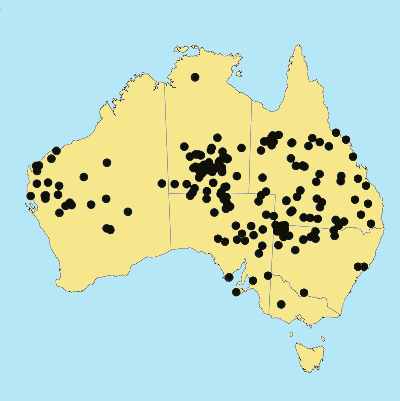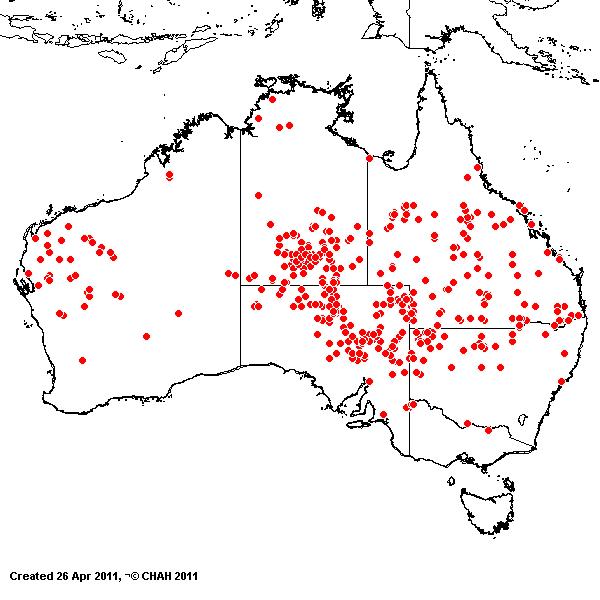Eragrostis leptocarpa Benth. Fl.
Austral. 7: 644 (1878).
Classification. (GPWG 2001) : Subfamily
Chloridoideae. Cynodonteae.
Type of Basionym or
Protologue Information: ST: Birch s.n., Australia:
Queensland: Mitchell District
ST: Giles s.n.,
Australia: Central
Australia: Charlotte
Waters.
Key references
(books and floras): [1878] G.Bentham, Flora Australiensis 7 (644),
[1952] C.A.Gardner, Flora of Western Australia 1 Gramineae (116),
[1981] M.Lazarides in J.Jessop (ed)., Flora of Central Australia (458),
[2002] D.Sharp & B.K.Simon, AusGrass, Grasses of Australia, [2006]
J.Jessop, G.R.M.Dashorst, F.M.James, Grasses of South Australia (375),
[2008] S.W.L.Jacobs, R.D.B.Walley & D.J.B.Wheeler, Grasses of New South
Wales (253).
Illustrations:
[1952] C.A.Gardner, Flora of Western Australia
1 Gramineae (117, Pl. 33), [2005] K.Mallet (ed.), Flora of Australia 44B:
Poaceae 3 (Fig. 68G-H), [2008] S.W.L.Jacobs, R.D.B.Whalley &
D.J.B.Wheeler, Grasses of New South Wales, 4th edn (253).
Habit. Annual
or perennial. Culms erect or geniculately ascending, stature slender to
delicate, 9–85 cm tall, 3–4 -noded. Mid-culm nodes glabrous. Leaf-sheaths
smooth, glabrous on surface. Ligule a fringe of hairs, 0.5–1 mm long.
Leaf-blades straight, flat or involute or convolute, 10–15 cm long, 2–3.8 mm
wide.
Inflorescence.
Inflorescence compound, a panicle. Panicle lanceolate or elliptic, 9–30 cm
long, 10 cm wide.
Spikelets.
Spikelets pedicelled. Fertile spikelets many flowered, with at least 2 fertile
florets (4–10), comprising 4–10 fertile floret(s), with diminished florets at
the apex, linear or lanceolate or elliptic, laterally compressed, 3–7.5 mm
long.
Glumes. Glumes
similar. Lower glume lanceolate, hyaline, without keels or keeled, 1-keeled, 1
-nerved. Upper glume lanceolate, 0.7–1.3 mm long, hyaline, without keels or
keeled, 1-keeled, 1 -nerved.
Florets.
Fertile lemma 1.4–2 mm long, keeled, 3 -nerved. Lemma apex muticous. Lodicules
present. Anthers 3. Grain 0.75–1.25 mm long.
Continental
Distribution: Australasia.
Australian
Distribution: Western Australia, Northern Territory, South Australia,
Queensland, New South Wales, Victoria.
Western Australia: Gardner, Dampier.
Giles, Helms, Fortescue, Ashburton, Carnarvon, Austin. Northern
Territory: Central Australia North, Central
Australia South. South Australia:
North-western, Lake Eyre, Gairdner-Torrens
Basin, Flinders
Ranges, Eastern, Murray. Queensland: Burke, Gregory North,
Leichhardt, Maranoa, Mitchell, North Kennedy, Port Curtis, South Kennedy,
Warrego, Gregory South, Cook. New South Wales: North Coast,
North-Western Plains, South-Western Plains, North Far Western Plains. Victoria:
Grampians.
Notes.
Distinguishing characters include slender habit; drooping decompound panicle
long relative to plant, with basal branches whorled; ciliate ligule; hyaline,
deciduous glumes, lemmas and paleas; unequal glumes; usually scabrous notched
lemmas; relatively wide palea flaps; minute terminally exserted anthers;
slender 3–4-angled caryopsis; linear loosely-flowered spikelet with vestigial
apical floret.
Endemic;
occurs from Carnarvon on the coast inland to Laverton, also Kunmunya in the N,
W.A.; central N.T. and to the N near Katherine; northern S.A. and also Port
Lincoln and Kangaroo Island to the S; around Cloncurry in the N E to c.
Springsure, Qld then S to about Wilcannia, N.S.W; also an old record from the Grampians
in Vic. In deep red and white sands, red-brown loams, and grey, black or brown
clays; commonly in seasonally wet habitats (in and near watercourses, lakes,
floodplains, swamps, depressions, sandhill swales); in association with
laterite, quartzite or granite.; flowers all year round.; fruits all year
round.





